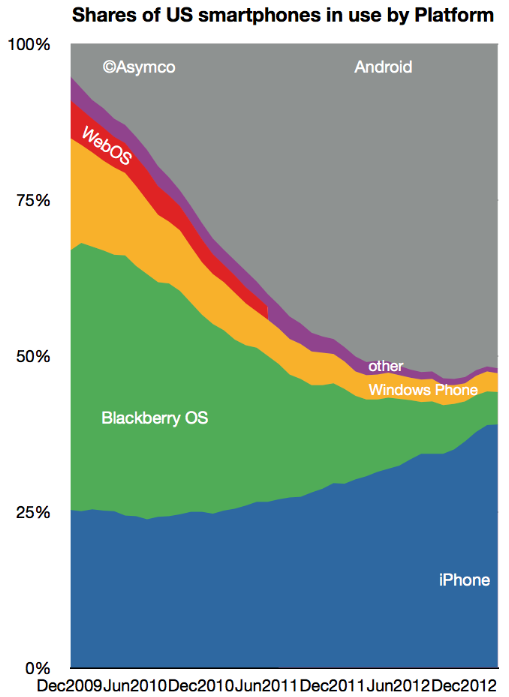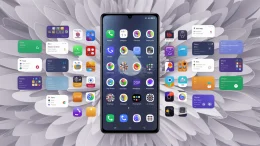You love the shockingly awesome camera on Nokia’s new Lumia 1020. You’re blown away by how cool Google Now is on its new Moto X phone. You’re impressed by the brilliantly big screen on the Samsung Galaxy S4.
But you’re not buying any of them. Instead, you’re waiting for the next iPhone to come out.
You’re not alone.
More Than A Matter Of Market Share

Despite Android’s steady march to roughly 80% market share, it’s not displacing Apple’s iPhone any time soon. If anything, the iPhone is making a resurgence against Android, at least in the U.S., with both Apple and Android spanking lesser rivals, as comScore data provided by Asymco demonstrates.
Of course, such market share data doesn’t account for profit share in the market. Apple still mints a 33% profit margin on its iPhones, compared to 19% profit margins at Samsung, according to IDC, lending Apple a gargantuan bank balance in excess of $150 billion. Even so, a year ago this translated into Apple claiming 71% of all industry profits, with Samsung taking much of the rest. Today, Samsung’s share of profits is soon to exceed Apple’s.
But there’s more reason for Apple fans to be cheery than just profits. After all, it turns out that very few people dump their iPhones for Android smartphones. The iPhone remains aspirational. Android phones? Not so much.
The iPhone Remains The Upgrade
This might be less the case if smartphone users were a fickle bunch. We’re not. Of the 326 million wireless subscribers in the U.S., only 19 million churn, or change to a different carrier each year. Of these, only 1% move off the major carriers like AT&T and Verizon.
With our smartphone brands, we’re even less likely to move. According to a Retrevo study, 81% of iPhone owners plan to stick with the iPhone for their next smartphone purchase, with a mere 4% expecting to jump to Android devices. Android users are far less loyal, with only 63% planning to stay with the Android platform, and a full 12% hoping to jump to the iPhone. In so-called “saturated” markets like the U.S., Android and iPhone are more even, with “smartphone competition… still primarily with non-consumption,” not between platforms, according to Horace Dediu of Asymco.
But this is with existing smartphone users or established markets. Where Android shines is for first-time smartphone users, where purchases are often driven by cost considerations, especially in emerging markets.
Android, then, is the gateway drug to smartphone adoption, but the iPhone remains the ultimate goal.
App Store Lock-in
Once a user is hooked on either platform, it’s hard to get off. Buyers get locked into a platform’s app store, particularly families that share accounts (like mine). Once an app store vendor bills you for a set of apps, as I’ve argued before, it’s hard to justify purchasing them again on another platform. Hence, app stores may only take 30% of an app developer’s sales, but they claim 100% of the end-user’s loyalty.
While this is a hard lock to crack, Apple seems to entice more people than any other platform to go through the bother of switching. Despite Android’s device dominance, Apple still has more and better apps for iOS. Apple’s App Store lock-in, and subsequent cloud services revenues, is much stronger than Android’s.
Or, as the Yankee Group argues in a research note, “Apple’s ‘black hole’ ecosystem captures subscribers who never leave.” Android’s, quite simply, does not.
Till Death Do Us Part?
Apple, then, is not nearly as vulnerable to Android’s market share gains as might first appear. So long as Apple maintains its position as the pinnacle of smartphone aspirations, it may be able to afford short-term market share hemorrhaging as it prepares for long-term relevance.
This isn’t to suggest it needn’t bother introducing low-cost models to compete with Android for first-time buyers. It should. While Apple does tend to scoop up churning Android users over time, far better (and more profitable) to collect them at the point of first sale.
Lead image courtesy of Ranpict.

















